
By Les Littlejohn
In the late 1920’s and early 1930’s passionfruit was regarded as an exotic fruit. Any specimens which arrived in Great Britain were eagerly sought and commanded a high price. Indeed, the wealthy placed the black passionfruit on the table ‘for exhibition only’. Motivated by the possibilities of the export trade to Great Britain and the rest of Europe, of both whole fruit and pulp, a new horticultural and manufacturing venture was established on the Mornington Peninsula in 1932. At its peak over 70,000 trellised passionfruit vines were planted on 400 acres. By 1937 it was considered to be the world’s largest single plantation, accounting for nearly 13% of Australia’s passionfruit production. But storm clouds were starting to appear and by February 1938 an extraordinary general meeting had passed a resolution to voluntarily wind up the company.
High Hopes
On 1 June 1931 an article appeared in ‘The Argus’ highlighting the great possibilities for an export industry and extolling the virtues of the Mornington Peninsula for the cultivation of passionfruit. Soon afterwards Passiflora Plantations Pty Ltd, formed in March 1932, issued a prospectus titled ‘The Story of Passionfruit’. Unlike the usual prospectus which quickly starts quoting statistics, forecasts, and an assortment of accounting data, the Trustees opted for a more subtle approach: the first page related ‘The Legend of El Dorado’.
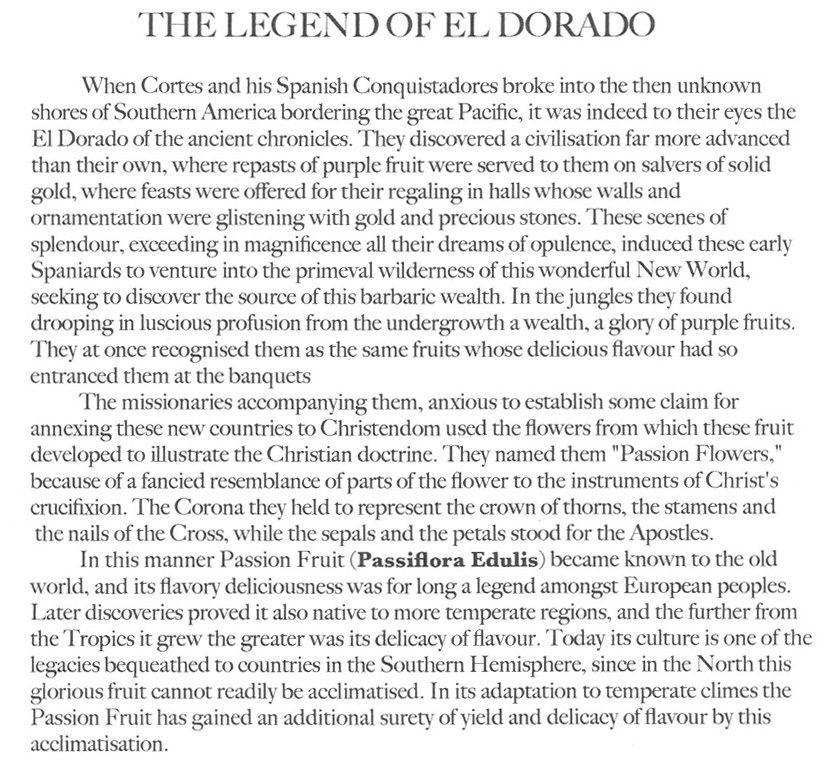
The prospectus advised that the company had selected land in the Dromana-Red Hill area, considering it to be the perfect locality for passionfruit cultivation due to rarity of frosts, friable porous soil, and with easterly facing slopes affording good drainage. The company also noted that in the moderate climate of Victoria vines could yield good crops for twenty years or more, whereas in the more tropical states replanting was required every four or five years. Furthermore, the company expected almost continuous cropping from February to October.
The prospectus indicated that it had a nominal capital of 10,000 pounds and offered 1,500 debentures at 10 pounds each. These funds would be used to plant 100 acres of vines; the debenture holders would receive a 6% return for the first two years while the vines were maturing and then 80% of the ensuing profits (an estimated return on investment of at least 50%, possibly even 100%). By means of a Trust Deed each debenture sold in the Series ‘A’ was to receive an interest equal to one-fifteenth of an acre of the freehold title. What could possibly go wrong?
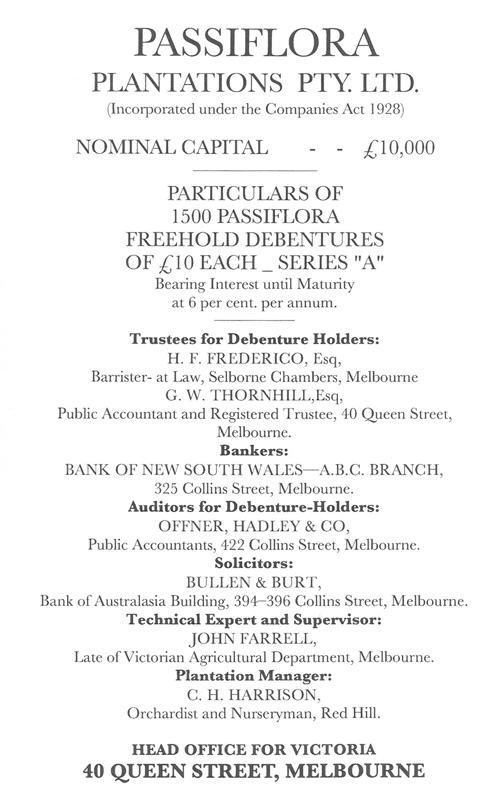

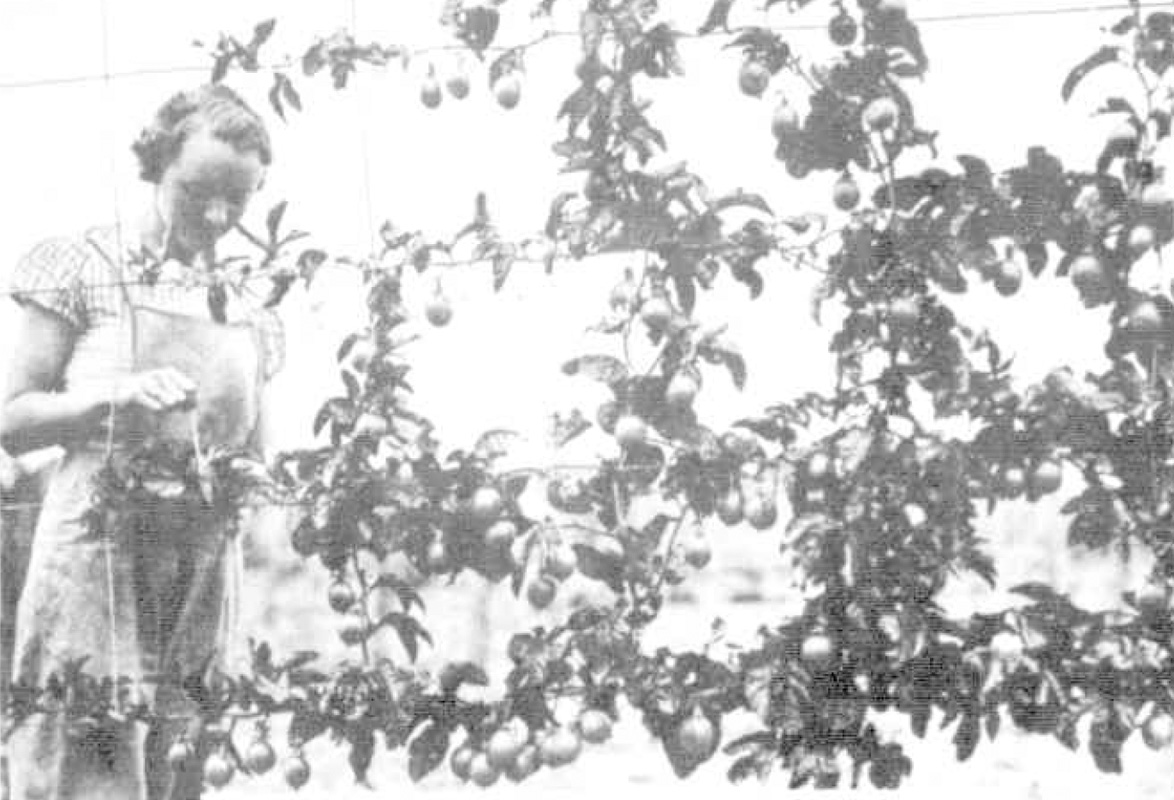
Full Steam Ahead
By 1934 a total of 100 acres had been planted with 20,000 vines and another 145 acres were in the planning stage. All vines were trellised and were reported to be in excellent condition, and wind breaks of pine trees were being established. In that year the company published a document titled ‘Passion Fruit for the World’ in which the company’s achievements were glowingly described, and inviting investors to subscribe to 1,000 ‘B’ series debentures at 25 pounds each to fund the development of the next 145 acres. A return of 6% was promised until 30 September, 1937 with a proportionate share of profits being paid to debenture holders thereafter. Subsequently, a third issue of 1000 debentures, each for 25 pounds, was made with the same promise of returns as for the ‘B’ series issue.
The Trustees annual report, issued in March 1935, made mention of the great progress being made in regard to planting, trellising, and the provision of water supply and drainage. The effectiveness of the drainage in dealing with excessive rains in December 1934 was noted.
Much of the fruit was processed into a range of cordial drinks in a factory on site by Passila Passion Fruit Products, an associated company of Passiflora Plantations Pty. Ltd., with exports to Asia and London. Both companies directly employed over 80 workers, many of whom were housed in purpose-built accommodation near the factory. In the aftermath of the Great Depression an enterprise of this scale was warmly welcomed by the Government so, not surprisingly, the Passila processing factory was officially opened by the then Acting Prime Minister, Dr. Earle Page (later Sir Earle and Australia’s eleventh Prime Minister) with much ceremony, in June 1935.
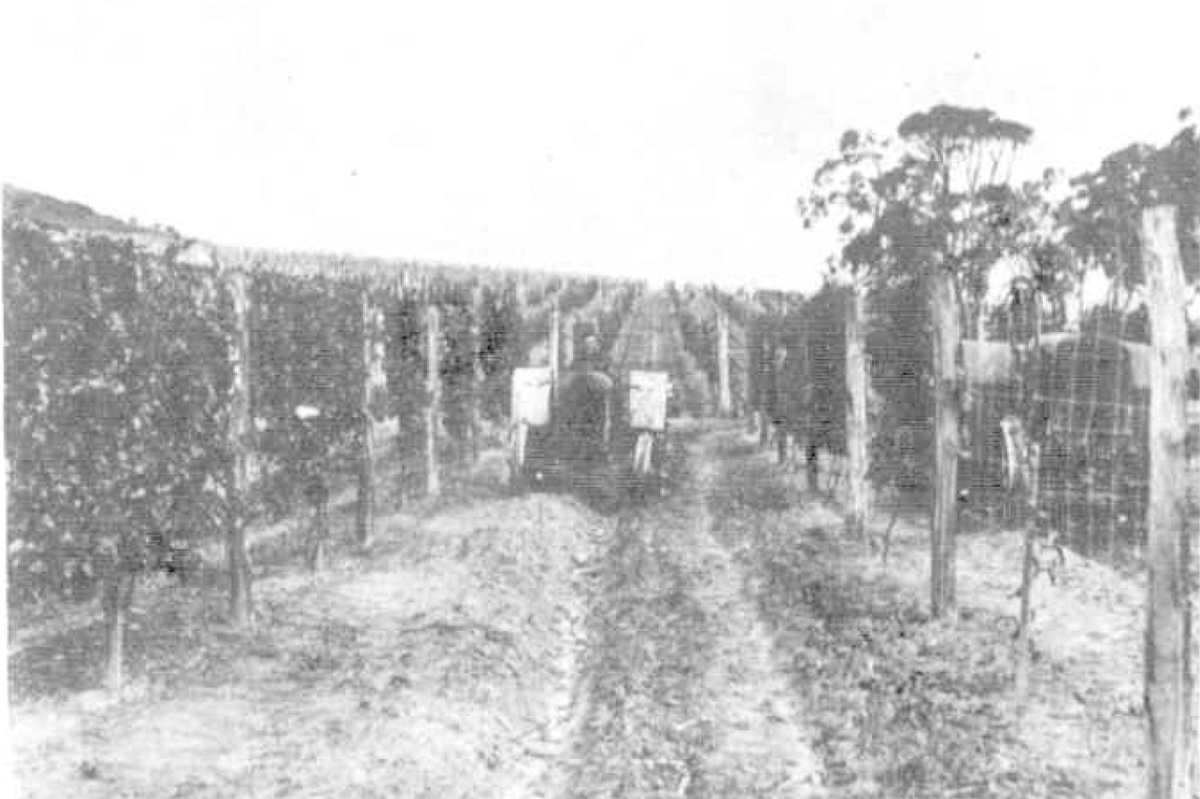

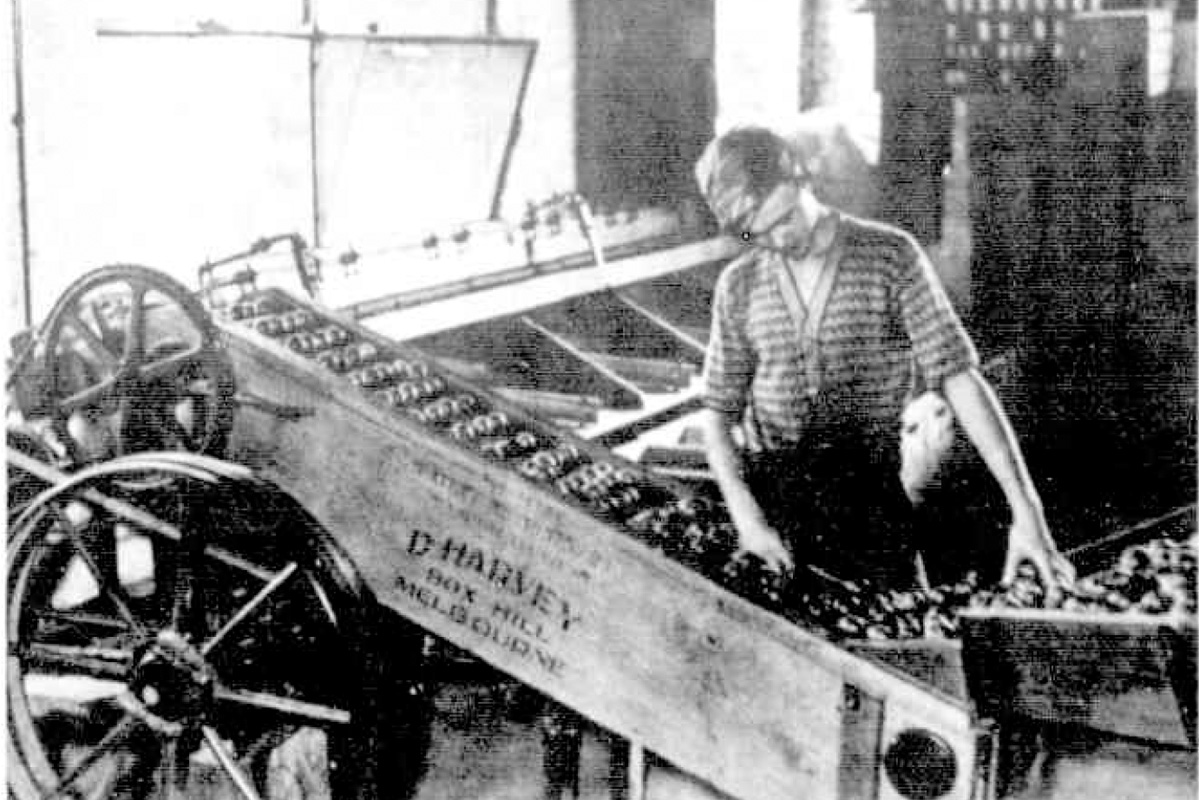
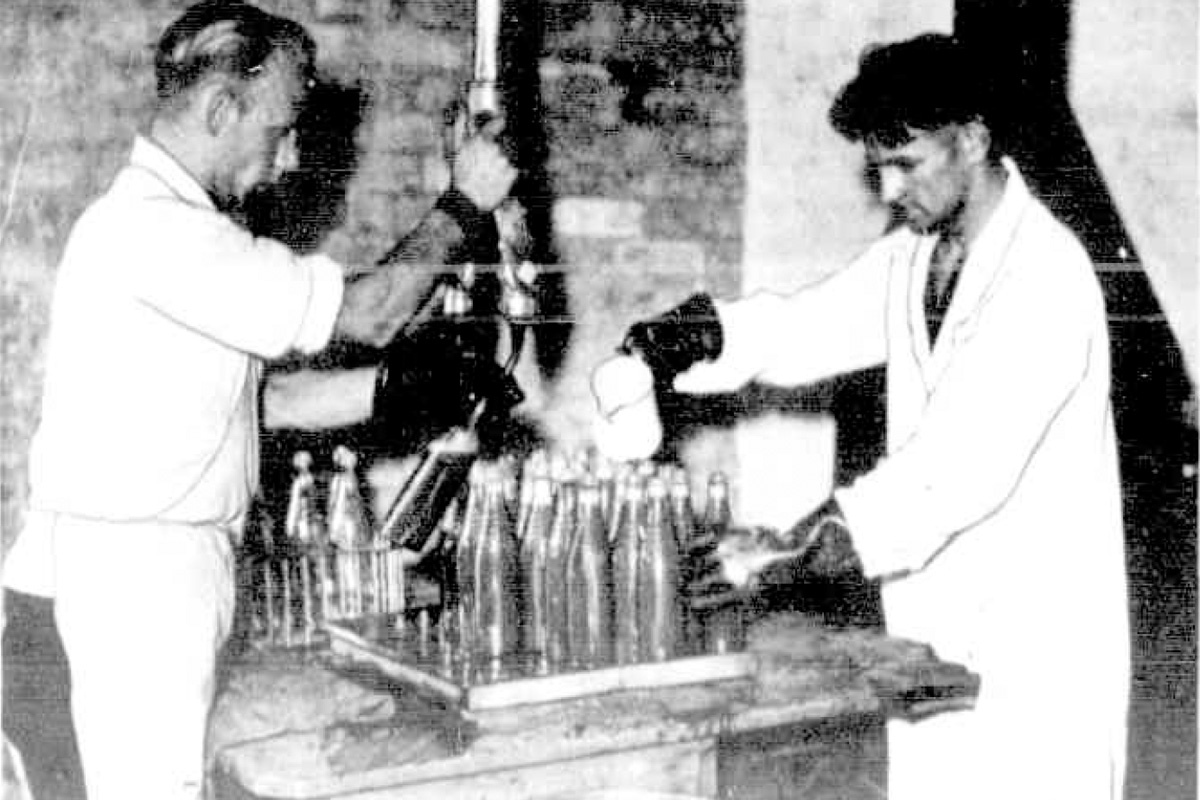
On 25 April 1936 the ‘Australasian’ carried a feature article on what it termed ‘The Largest Passion Fruit Plantation in the World’. The glowing report stated that: “Passiflora Plantations Pty. Ltd. is in the unique and enviable position of having demand for its products greatly exceeding supply.” It recorded that: “At the present time an area of about 300 acres has been planted, and the work of clearing is carried on to provide for further planting, which ultimately will be around 400 acres. Some idea of the magnitude of this work would be conveyed by the fact that the whole of the trellis, if stretched into one line, would extend a distance greater than from Melbourne to Sydney.”
The report also endorsed the techniques employed by the factory of Passila Passion Fruit Products, ensuring that “…the subtle qualities of flavour, bouquet and aroma give character to the product.”
On 5 December, 1936 ‘The Age’ reported enthusiastically on the project, “now growing 72,000 vines.” It also recorded: “Arrangements are in hand for planting an additional 90 acres, which will bring the total under vines to 390 acres. This area, when in full bearing, is expected to produce 250,000 cases a year.”
A report in ‘Smiths Weekly’ on 8 May 1937 stated: “Today the (company’s) plan is reaching the final stages: the planted area totals over 310 acres carrying approximately 75,000 passion fruit vines and next year it is hoped to see the original programme to develop 390 acres with 100,000 vines completed.” From this comprehensive account it would appear that the future was assured: good crops, ready markets and continued expansion.
On 24 June 1937 both ‘The Argus’ and ‘The Age’ reported on the annual meeting of Passila Passion Fruit Products Pty. Ltd., held on the previous day. A resolution to increase the nominal capital by 10,000 pounds was approved but it was noted that: “Considerable difficulty has been experienced during the year in securing ample supplies of passionfruit to meet the growing demand for Passila…”
Storm clouds were evidently gathering despite the general optimism. Possibly the local production of passionfruit was not as high as anticipated as the factory was forced to supplement its supply from elsewhere, even interstate. Furthermore, the profit and loss account for the ’A’ series plantation shares shows that the returns were well short of the predictions made in the 1932 prospectus.
High Hopes Dashed
A clear indication that the company was struggling was evident when the Public Records Office of Victoria published the following notice early in 1938:

Liquidators were appointed and a meeting of creditors was convened on 24 February 1938. The following day ‘The Argus’ reported: “The affairs of this company are complicated by the existence of three debenture trustees. As there are likely to be large claims from the receiver for the debenture holders, the creditors’ position is still uncertain.”
In March of 1938 the businesses were offered for sale by tender; apparently they were still a going concern. It would appear that no acceptable tender was forthcoming as the property was advertised for sale by auction on 5 October 1938:
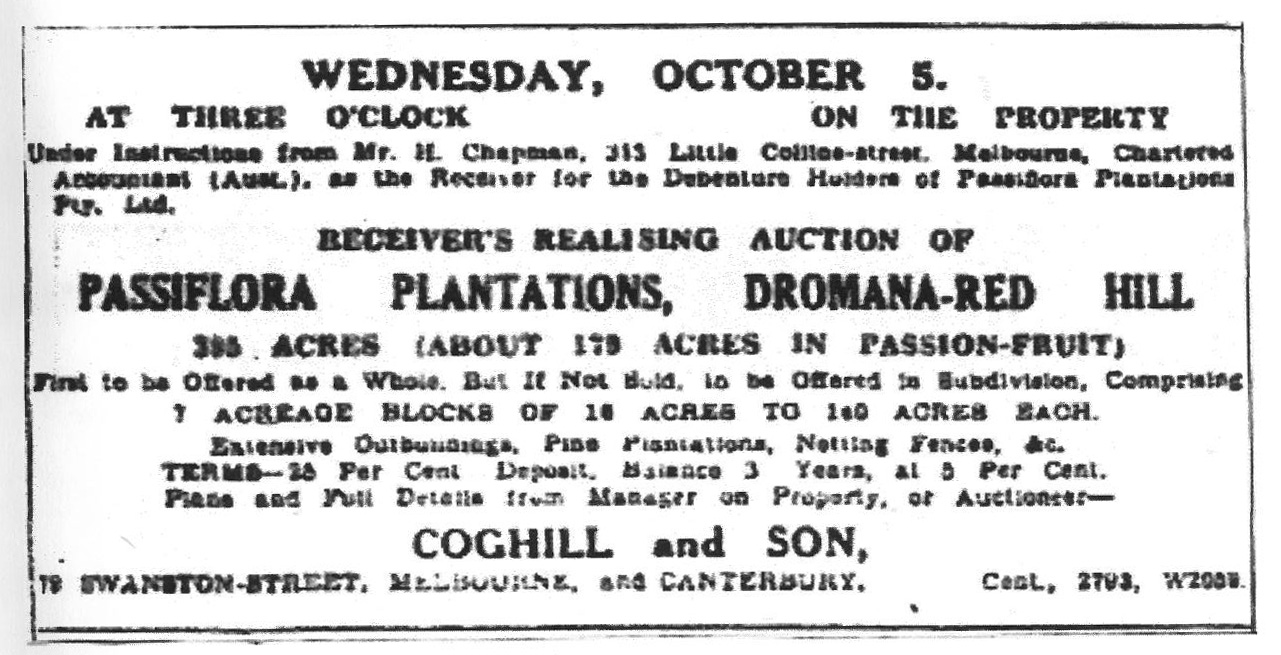
The notice states that there are 395 acres with about 179 of those planted to passionfruit; this contrasts with figures quoted by the company in 1935 of 571 acres with plans to have in excess of 400 acres under cultivation. One can only conclude that some land had been sold previously and some plantings disestablished.
Evidently the property was not sold at auction. On 14 January 1939 an advertisement appeared in ‘The Argus’ offering the Passila factory for sale, firstly as a complete unit including all machinery. If still not sold the building and land would be offered in one lot with the machinery being offered separately. If not sold in one lot the machinery would be offered in individual lots.
Then, on 2 February 1939, an article appeared in ‘The Age’ indicating that a syndicate had purchased “…the goodwill, trade-marks, factory and plant of Passila Fruit Products Ltd.” from the liquidators. Capital was now to be raised. Little information is available as to the fortunes of this new company but the outbreak of World War 11 with the resulting restrictions and rationing would certainly have had an adverse impact on its fortunes. On 6 January 1948 a notice appeared in ‘The Age’ with a proposal to wind up that company.
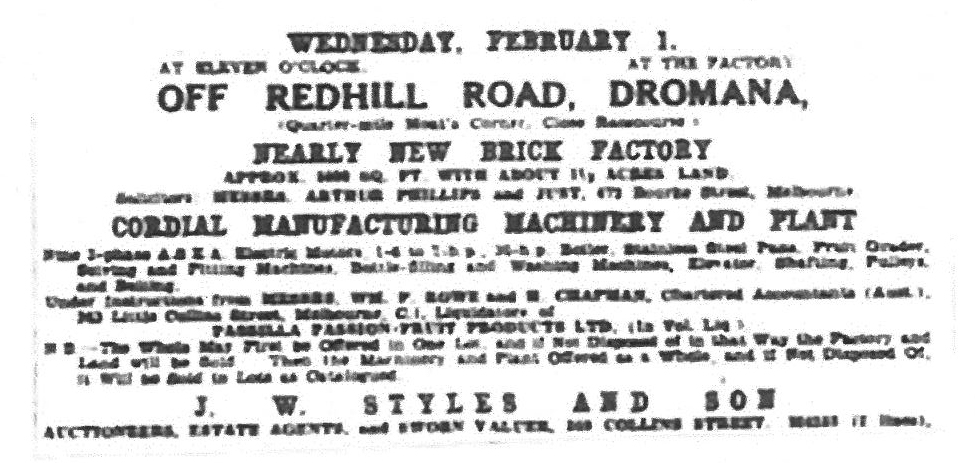
The Demise Of The Plantation
So how did this venture which promised so much end so quickly? The industry certainly experienced a rapid decline. One report states that in 1937-38 there were about 150,000 passionfruit vines growing in Victoria; in 1944 the number was down to 33,000. Various diseases took a heavy toll, the major one being a virus known as ‘woodiness’, the fungus troubles causing root rot and brown spots on leaves and fruit.
Apart from the disease, doubts were also expressed regarding the life expectancy of the Passiflora Edulis vines. The Rare Fruit Council of Australia considers six years as being a good, long life with four years being the norm for commercial cultivation. One particular reference states that many vines die as early as three or four years, while another states that a variety of fatal diseases makes commercial growing a dicey proposition, with the lifespan of vines rarely exceeding six years. All of this is at sharp odds with the company’s prediction of a twenty year productive life from the vines. The earliest planted vines could have been nearing the end of their productive lives by the early 1940’s even without the influence of disease.
While disease and an unrealistic life expectancy of the vines were undoubtedly the principal factors in the demise of the passionfruit plantation, one observer mentioned “frost damage” as an additional factor.

What Next?
No change of ownership occurred until 17 July 1944 when the property was acquired by George McNaught Hume. There is some speculation that Cottees may have bought the property and continued processing the fruit. A search of the property title refutes this theory. Apparently fruit from the property did find its way into their products even though they had no direct involvement in the plantation.
Perusal of the title reveals that Tuisko Turso Seppelt purchased the property in June 1950 and held it for just over a year before selling it to Clifford David Adams, a member of the Herbert Adams family, in July 1951. Seppelt apparently planted wine grapes on the site but the rabbits were a formidable obstacle.
In 1955 Ken Broadhurst purchased the property and ran it largely as a dairy farm. However his brother-in-law, Doug Seabrook, operated a vineyard in one part; birds eating the fruit were his main problem. Broadhurst subdivided the property into three lots in 1965 and it was then sold. Soon afterwards, in 1967, a bushfire swept through the area and any remaining vines were destroyed.
The northernmost area, which included the old processing factory, is now a picturesque rural vineyard of some 50 acres which was planted in 1998. The red brick factory building, with some additions, retains its original structural elements. It serves as a cellar door and restaurant, providing the Trofeo Estate, located in Harrisons Road, with an historical ambience. The men’s quarters from the old plantation days still exist as a residence.
The Trofeo Estate is unusual in Australia in that all of its wines are aged in a traditional Mediterranean style in Florentine Terracotta Amphorae, an ancient wine making vessel steeped in history and linked to the wine making traditions of the Ancient Greeks, Romans and Etruscans.
In conclusion, it could be said that the men who founded the enterprise had the best of intentions and carried out all the work to a high standard, but were unable to realize their vision largely due to unforeseen difficulties with disease in the plantation.




Footnote:
The story of the Mornington Peninsula’s flirtation with passionfruit is one of many to be found in Malcolm Gordon’s newly-published ‘A Never Ending Journey.’ It is available at bookshops, many newsagencies and several wineries across the peninsula.





